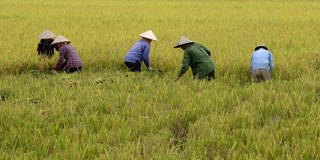Asia is already the world’s largest food market, and its population is expected to increase to five billion by 2050. To ensure adequate food supplies, the region's governments will have to promote a new agricultural model that enables farmers to increase yields, cut costs, and adapt to climate change.
MANILA – Food shortages are a distant memory for many people in Asia. But as the region struggles to feed and nourish a booming population, they could become a painful fact of life again.
Asia is already the world’s largest food market, and by 2050 its population is expected to grow to five billion – an increase of 900 million people. Owing to its expanding middle class, the region will likely account for half of the global increase in annual beef and poultry consumption and over three quarters of the rise in fish consumption between now and 2030. And by then, more than 60% of total cereal demand in the developing world will come from South and East Asia. To keep up with this growing demand, food production will have to increase by 60-70% compared to a decade ago.
Ideally, Asia’s farms could simply expand their production. But they are woefully ill-equipped to do so. To produce a sufficient amount of food, Asia’s farms will need to undergo a twenty-first-century transformation.

MANILA – Food shortages are a distant memory for many people in Asia. But as the region struggles to feed and nourish a booming population, they could become a painful fact of life again.
Asia is already the world’s largest food market, and by 2050 its population is expected to grow to five billion – an increase of 900 million people. Owing to its expanding middle class, the region will likely account for half of the global increase in annual beef and poultry consumption and over three quarters of the rise in fish consumption between now and 2030. And by then, more than 60% of total cereal demand in the developing world will come from South and East Asia. To keep up with this growing demand, food production will have to increase by 60-70% compared to a decade ago.
Ideally, Asia’s farms could simply expand their production. But they are woefully ill-equipped to do so. To produce a sufficient amount of food, Asia’s farms will need to undergo a twenty-first-century transformation.